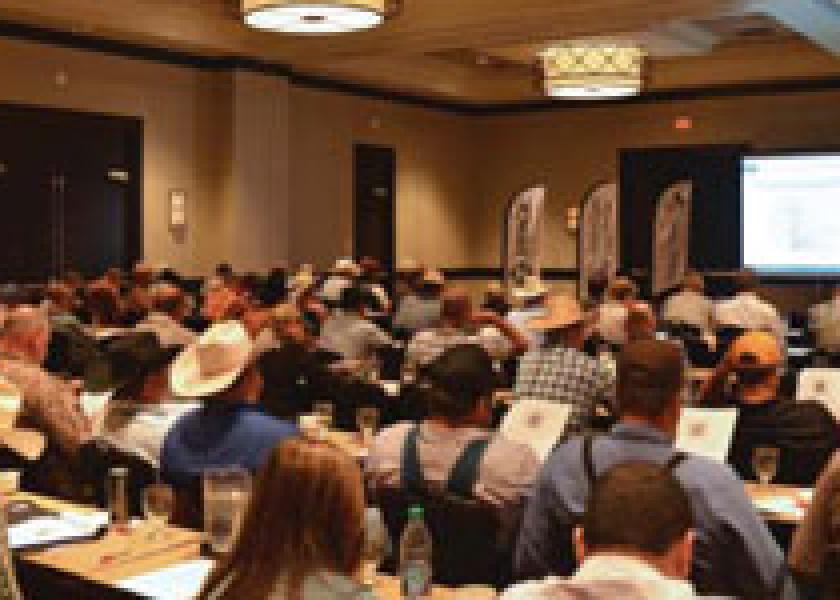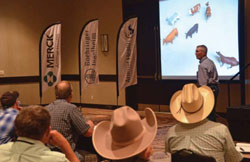Prevent a Wreck in High-Risk Cattle

Health challenges are bound to occur in high-risk cattle in the feedlot, but the impact can be reduced
Anyone who feeds cattle has likely had a health “wreck” or two happen in their lifetime. Whether it’s a pen of cattle not gaining weight from poor preconditioning or half a pot-load ending up in the dead pile thanks to a persistently infected bovine viral diarrhea (PI-BVD) calf, wrecks are costly. Identifying when a wreck might happen can be difficult, but there are measures to increase profit opportunities even when feeding high-risk cattle.
 |
Dan Thomson (left) says processing cattle through the chute is a quality event, not a timed event. |
Seeking ways to manage high-risk cattle, more than 85 beef producers from 14 states gathered in Wichita, Kan., for Beef Today’s second annual Feedlot Cowboy College on Sept. 15 and 16. Two veterinarians attending from Australia and Brazil gave the event an international perspective as well.
The two-day educational program was designed specifically for feedlot cattle crews—processing teams, cowboy doctors and others involved in the day-to-day care and welfare of feedlot cattle. Recognizing and managing high-risk calves was the focus for the cattlemen in attendance.
The program featured industry-leading veterinarians Dan Thomson, director of the Beef Cattle Institute at Kansas State University; Mike Apley, Kansas State University professor; and Tom Noffsinger, animal handling expert and feedlot consultant from Benkelman, Neb.
High-risk calves tend to be cattle that haven’t been straightened out prior to entering a feedlot. They often originate from sale barns, are commingled groups or have been freshly weaned from a ranch.
 |
Dan Thomson led off a discussion on receiving cattle, pointing out health isn’t the reason high-risk cattle are categorized that way.
“The people who are buying the cattle classify them as high-risk because they are hard to predict what is going to happen economically with those cattle,” Thomson says.
Most procurement people and order buyers aren’t sure if high-risk cattle are going to get sick or not, but Thomson says the expectation is for 4% of high-risk calves to be dead before the end of the feeding period, compared to less than 1% with low-risk cattle.
High-risk cattle have a lot of variation in how they might perform because their origins are hard to trace. It is difficult to know how many times a group of calves have been through a sale barn or if they’ve ever been vaccinated.
 |
In the U.S., commingling cattle is a necessary evil as the average herd size is 40 cows. That means it’s nearly impossible to fill a feedlot pen with calves from only one location.
“The key is to prepare the animal before they are commingled. Give them a chance with immunizations,” Thomson says.
In a study conducted by Thomson, sale barn tags were scanned from truckloads of 100 calves originating out of the Southeast. There was an average of 32 sale barns and five different states represented. “That’s some pretty serious commingling,” Thomson adds.
 |
The cattle you take to the hospital are important, says Tom Noffsinger, but the ones you worry about are still in the pen. |
Add-ons, or animals arriving at different times, are another part of the commingling puzzle. “Once cattle come into a feedyard, if we do not fill the pen within a week, a wreck is coming,” Thomson says. “Our research shows five days, but if it takes you longer than a week to fill a pen, you’re going to have cattle from different places, with different viruses and immune response.”
When those pens are full, pen riders need time to be able to spot cattle that are sick or have other ailments to prevent a wreck. “The more high-risk cattle we bring to a facility at once, the higher risk our low-risk cattle become because we’re spending more time with the high-risk cattle,” Thomson explains.
Tom Noffsinger agrees, noting a feedlot can take in low-risk calves and turn them into high-risk calves with improper handling. But there are cases where high-risk cattle can turn into low-risk, too.
The first key to lowering health risk is for cattle to be handled with low-stress animal handling principles. “It is this idea that you as a human have a responsibility to make a difference to each other and a difference to the animals you’re taking care of,” Noffsinger says.
Starting out as a veterinarian, Noffsinger used the tools that were in his pickup: vaccines, antibiotics and trace minerals. “That’s about all I had to solve problems with,” he says.
Unfortunately, those tools don’t solve every problem that occurs when caring for cattle on a daily basis. There aren’t syringe and needle fixes to prevent toe abscesses or bullers.
“At the end of the day, these low-stress handling skills were something I could put in my tool box,” Noffsinger says. “Low-stress handling is something you can put in your toolboxes that will give you more opportunities to make a difference in your daily output.”
Cattle have a nearly 360° peripheral vision, and as a prey species, they crave to see what it is around them. However, depth perception tends to be a problem, so cattle will move their heads up and down to see a person when pushed through an alley to a chute or waking through a gate. That is why connecting with the eye is the most vital part of handling cattle.
“It is the key to position,” Noffsinger says of the eye. It is not the shoulder, which some animal handling experts have interpreted as the point of balance. “If you can’t find an eye, you are in the wrong place.”
 |
Mike Apley (center), consults with Kip Harms, a cattle backgrounder, and Tom Noffsinger about BRD treatment. |
Even when animal handling and vaccinations are done correctly, there can still be sick animals, so antibiotics are needed in some situations. Producers who use antibiotics will face challenges in 2017 when the Veterinary Feed Directive (VFD) goes into full effect.
Mike Apley, recently named to the Presidential Advisory Council on Combating Antibiotic-Resistant Bacteria, outlined what feedlot crews can expect with the VFD.
“The Veterinary Feed Directive is a written statement only,” Apley says. “You’ll only be able to get medically important antibiotics for use in feed on the basis of a written Veterinary Feed Directive.”
The VFD must come from a veterinarian licensed in the state where the animals are being fed. There must be a valid veterinary-client relationship as well.
Currently, the VFD only applies to a couple of drugs used in fish and swine production, along with tilmicosin (Pulmotil) in cattle. By December 2016, all medically important feed-grade antibiotics will be included in the VFD and they will have to be followed according to their updated labels on Jan. 1, 2017. Antibiotics used in water will also be subject to the VFD and require a prescription.
There are several feed-grade antibiotics that will be regulated by the VFD, but common ionophores such as monensin (Rumesin), lasalocid (Bovatec) and laidlomycin (Cattlyst) will not be subject to VFD when used on their own.
If a feedlot were to feed monensin with tylosin or any other medically important feed-grade antibiotic however, it would require a VFD, Apley says.
A copy of the VFD must be retained by the feedlot and veterinarian for two years because the Food and Drug Administration (FDA) can inspect you at any time they want during that period.
“Producers need to keep those VFDs. Even if a violation of slaughter residue happens at another client of the veterinary clinic who wrote the VFD, the FDA can choose to spot check the rest of the people written VFDs,” Apley says.
Distributors of feed-grade antibiotics will also be subject to the same scrutiny as livestock producers and veterinarians when it comes to VFDs.
Apley cautions for producers to “be prepared” when the VFD takes full effect and do not attempt extra-label use. “If it is not on the label, it is illegal to use it in an unauthorized way.”







